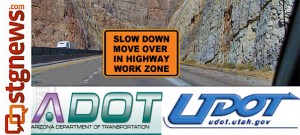
ST. GEORGE – According to a recent release of the Arizona Department of Transportation, highway construction and maintenance work is one of the most dangerous occupations in the United States, and the recent and tragic death of a highway maintenance worker in South Carolina serves as a reminder that driving with caution in highway work zones saves lives.
“We are asking drivers to be mindful and give their undivided attention when entering a highway work zone,” ADOT director John Halikowski said. “Work zones can be hazardous not only to the driver and their passengers, but also the ADOT staff members who perform critical work on our highway system and put their lives on the line every day.”
The concern is common to Utah. “Over the years we’ve had highway patrolmen and their cars hit because people are driving distracted or too fast . . or an officer is out with someone outside of the road,” Utah Department of Transportation’s incident management team supervisor, Todd Abbott, said. And UDOT has had contractors working on a highway project and people drift off into a closed lane and hit or nearly hit a contractor or employee.
Utah has had its own recent reminders of the dangers to road workers. Thayne Hansen, was struck and killed by a car making an illegal turn while he was repairing a storm drain in Draper in April; and three workers died in three days in August 2011 on Interstate-15, state Route-10 and a rural road in Carbon County.
Since the 1940‘s, 60 workers have been killed along Arizona’s highways, the last in 2006.
In an effort to reduce the number of injuries and fatalities to emergency responders and law enforcement officers, many states have adopted “Move Over” laws. While the particulars vary, the gist of these laws is to require or encourage drivers to give space to emergency vehicles, vehicles that are stationary on the highways, and construction zones.
Utah’s Move Over Law requires drivers approaching a stationary authorized emergency vehicle, tow truck or highway maintenance vehicle displaying flashing lights, to reduce speed, provide as much space as practical to the authorized emergency vehicle, the stationary tow truck or highway maintenance vehicle; drivers in a lane adjacent to emergency vehicles flashing lights are required to make a lane change into a lane not adjacent to the emergency vehicles if it is practical and safe to do so and traffic conditions allow it.
Arizona’s Move Over Law, adopted in 2005, requires drivers to either move one lane over or slow down when they encounter a vehicle pulled over to the side of the road with lights flashing. It was amended in 2011 to include tow trucks, maintenance vehicles and all other vehicles using lights.
“Arizona’s Move Over Law was enacted to protect and save lives,” Halikowski said. “When you spot an emergency or maintenance vehicle parked on the shoulder with their flashing lights on, drivers need to move over to create more space. If that’s not possible, then you need to slow down and use extra caution.”
While Utah’s law is a little different from Arizona’s law pertaining to construction zones, nonetheless “it’s the law,” Abbott said, “slow down, move over for emergency vehicles, highway maintenance crews, people that have car trouble.”
ADOT’s recommended driver tips for safety:
• Expect the unexpected. Speed limits may be reduced, traffic lanes may be restricted and people may be working on or near the road.
• Stay alert. Avoid distractions such as using your cell phone or adjusting the radio while passing through work zones.
• Keep at a safe distance from other cars, preferably two car lengths. The most common type of work zone accident is rear-end collision.
• Keep up with the traffic flow. Merge as soon as possible and do not drive right up to the lane closure and try to barge in.
• Slow down. Speeding is another major cause of work zone accidents.
• Observe posted signs; they are there to help you move safely through the work zone.
• Obey road crew flaggers. In Arizona, they have the same authority as regulatory signs and you can be cited for disobeying their directions.
• Be patient. Remember that road crews are working to improve the road and your commute.
Check road conditions before setting out on a trip by calling 511 or visiting Utah CommuterLink or AZ 511.
St. George News staff reporter Alexa Verdugo Morgan contributed to this report.
Email: [email protected]
Twitter: @JoyceKuzmanic
Copyright St. George News, SaintGeorgeUtah.com LLC, 2012, all rights reserved.

Great article but as daily driving shows people think it is their road and they could careless about others on it. All the distracted driving is just amazing. Cell phones being the biggest, someone tell me what call is more important then your life or some other motorist life?
It is not always the drivers fault, many times I have witnessed workers step over their cones into traffice lanes without even looking up. Takes drivers and workers to be safe.
On occasion you will see that happen. However, nearly 100% of the time drivers will speed through construction zones with total disregard for the safety of the peole working there. They are angry and offended that these barricades and traffic devices have delayed their important schedule by 2-3 minutes. That’s where the problem is “and” the reason for this story.
Just like on Riverside Dr. speed limit is 20 and people are still going 40 or more! Police need to do traps in these areas..fines do double!